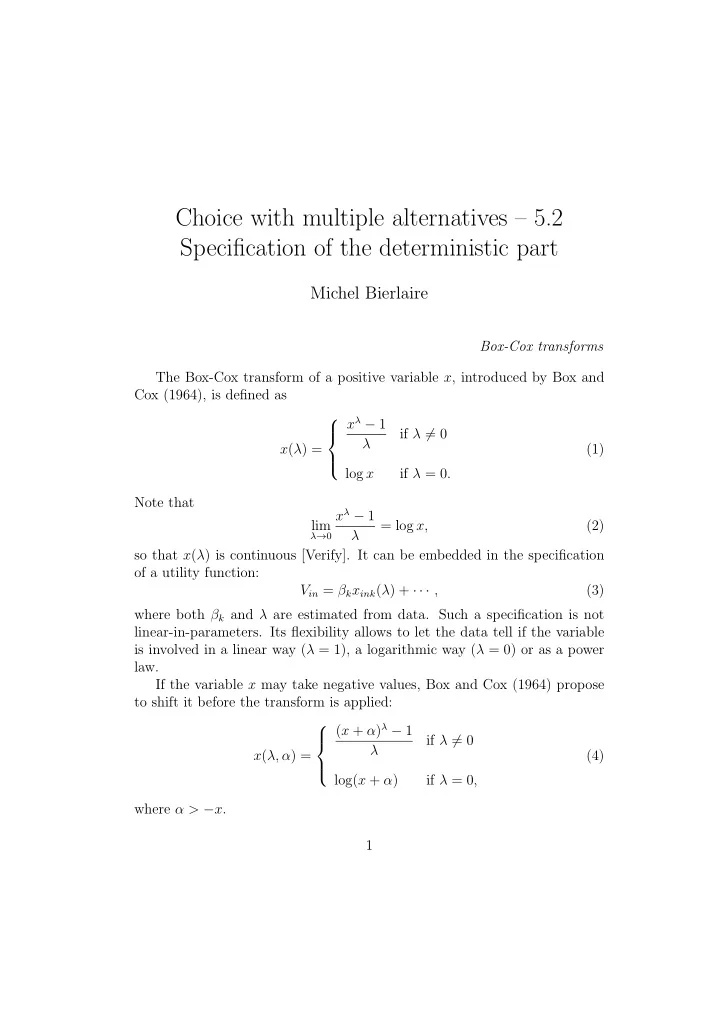

Choice with multiple alternatives – 5.2 Specification of the deterministic part Michel Bierlaire Box-Cox transforms The Box-Cox transform of a positive variable x , introduced by Box and Cox (1964), is defined as x λ − 1 if λ � = 0 λ x ( λ ) = (1) log x if λ = 0 . Note that x λ − 1 lim = log x, (2) λ λ → 0 so that x ( λ ) is continuous [Verify]. It can be embedded in the specification of a utility function: V in = β k x ink ( λ ) + · · · , (3) where both β k and λ are estimated from data. Such a specification is not linear-in-parameters. Its flexibility allows to let the data tell if the variable is involved in a linear way ( λ = 1), a logarithmic way ( λ = 0) or as a power law. If the variable x may take negative values, Box and Cox (1964) propose to shift it before the transform is applied: ( x + α ) λ − 1 if λ � = 0 λ x ( λ, α ) = (4) log( x + α ) if λ = 0 , where α > − x . 1
There are other ways to impose the positivity of the argument of the transform. For instance, Manly (1976) suggests to use an exponential: � e xλ − 1 if λ � = 0 x ( λ ) = (5) λ x if λ = 0 , while John and Draper (1980) propose to use the absolute value: sign( x ) ( | x | +1) λ − 1 � if λ � = 0 x ( λ ) = (6) λ sign( x ) log( | x | + 1) if λ = 0 . A more complex transform has been proposed by Yeo and Johnson (2000): ( x + 1) λ − 1 if λ � = 0 , x ≥ 0; λ log( x + 1) if λ = 0 , x ≥ 0; x ( λ ) = (7) (1 − x ) 2 − λ − 1 if λ � = 2 , x < 0; λ − 2 − log(1 − x ) if λ = 2 , x < 0 . Plenty of references are available in the literature. We refer the reader to Sakia (1992) for a review, and to Zarembka (1990) for a discussion in terms of model specification. References Box, G. E. and Cox, D. R. (1964). An analysis of transformations, Journal of the Royal Statistical Society. Series B (Methodological) pp. 211–252. John, J. and Draper, N. (1980). An alternative family of transformations, Applied Statistics pp. 190–197. Manly, B. (1976). Exponential data transformations, The Statistician pp. 37– 42. Sakia, R. M. (1992). The box-cox transformation technique: A review, Journal of the Royal Statistical Society. Series D (The Statistician) 41 (2): 169–178. URL: http://www.jstor.org/stable/2348250 2
Yeo, I.-K. and Johnson, R. A. (2000). A new family of power transformations to improve normality or symmetry, Biometrika 87 (4): 954–959. Zarembka, P. (1990). Transformation of variables in econometrics, Econo- metrics , Springer, pp. 261–264. 3
Recommend
More recommend